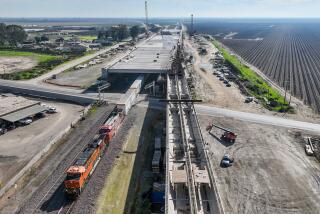Amtrak Threatens to Halt Red-Ink Routes
- Share via
WASHINGTON — Amtrak said Friday that it will shut down later this year all long-distance routes that don’t turn a profit unless Congress more than doubles its annual subsidy to $1.2 billion.
The national passenger rail system also announced immediate spending cuts of $285 million, including the elimination of 1,000 jobs, or 4% of its work force.
“Everyone knows that you can’t make a profit while running a network of unprofitable trains, but that’s exactly what we’re expected to do,” Amtrak CEO George Warrington said.
Odds of getting the $1.2 billion seem remote in a budget year when military and security spending are the priorities and the federal deficit has reemerged.
Efforts to turn Amtrak into an independent, profit-making enterprise are widely acknowledged to be petering out in failure. Last month, a federal reform commission recommended that the system be broken up into smaller regional companies, which could be operated by state and local governments or private entities.
However, Amtrak still has considerable support on Capitol Hill, and many lawmakers believe the federal government should continue to subsidize rail service indefinitely.
Five interstate trains serving California may be permanently sidelined if Amtrak follows through with its proposed cuts in October, spokeswoman Vernae Graham said. They are the California Zephyr, linking Chicago and the Bay Area; the Coast Starlight, between Seattle and Los Angeles; the Southwest Chief, from Chicago to Los Angeles by way of Kansas City, Mo.; the Sunset Limited, from Orlando, Fla., to Los Angeles; and the Texas Eagle, from Chicago to Los Angeles by way of San Antonio.
Routes within California--such as the Pacific Surfliner between San Luis Obispo and San Diego--would not be affected, Graham said. Those routes are supported by state subsidies.
Amtrak ticket revenues have risen 26% since 1997, while ridership grew 11%. But expenses have grown even faster. For every $1 in additional revenue, expenses grew by $1.05, according to a report last month by the Transportation Department’s inspector general. As a result, the system last year suffered its worst operating loss: $1.1 billion.
“It is not clear whether Amtrak or any other entity could ever operate a linked national system such as that in place today without operating subsidies,” the report concluded. “Congress will need to weigh the likely costs of subsidizing a linked national system against the merits of preserving such a system.”
In addition to its operating shortfall, Amtrak needs $1 billion a year in capital investment “for the foreseeable future,” the inspector general’s office found.
Congress has appropriated $521 million for Amtrak in the current budget year. Measured against that funding level, the $1.2-billion request represents a 130% increase.
House Transportation Committee Chairman Don Young (R-Alaska) branded Amtrak’s request as “irresponsible” and said he will hold hearings to explore reforms. He questioned the rationale for maintaining the current extensive route system.
But his Democratic counterpart, James L. Oberstar of Minnesota, said the real problem is that Congress has underfunded the rail service. “We need to invest in Amtrak, not destroy it,” Oberstar said.
On top of its annual subsidy, Amtrak also received an additional $418 million from the government in the current budget year, bringing the total to $939 million. Measured against that funding level, the $1.2-billion request for the coming year still is significant, about 28%.
Amtrak spokeswoman Kajal Jhaveri said the request has to be seen in the context of government subsidies for roads and aviation. “We might be asking for an increase of 100%, but highways and aviation received $46 billion,” Jhaveri said. “We are asking for this to accommodate the basic needs to manage and operate the system.”
Long-distance rail service is Amtrak’s biggest money loser. According to the inspector general’s report, it posted an operating loss of $304 million last year. “Amtrak has historically struggled with generating growth on intercity trains, which represent most of Amtrak’s long-distance routes,” the report said.
Amtrak’s Northeast corridor and local West Coast routes have posted better results and, as a consequence, have a more promising future.
Consumer qualms about returning to air travel also could benefit the rail system.
“In the current economic climate, and in the wake of the terrorist attacks, Amtrak’s relative performance has been more promising than its competitors,” the inspector general found. While air travel dropped after Sept. 11, Amtrak ridership held steady and revenues grew modestly.


